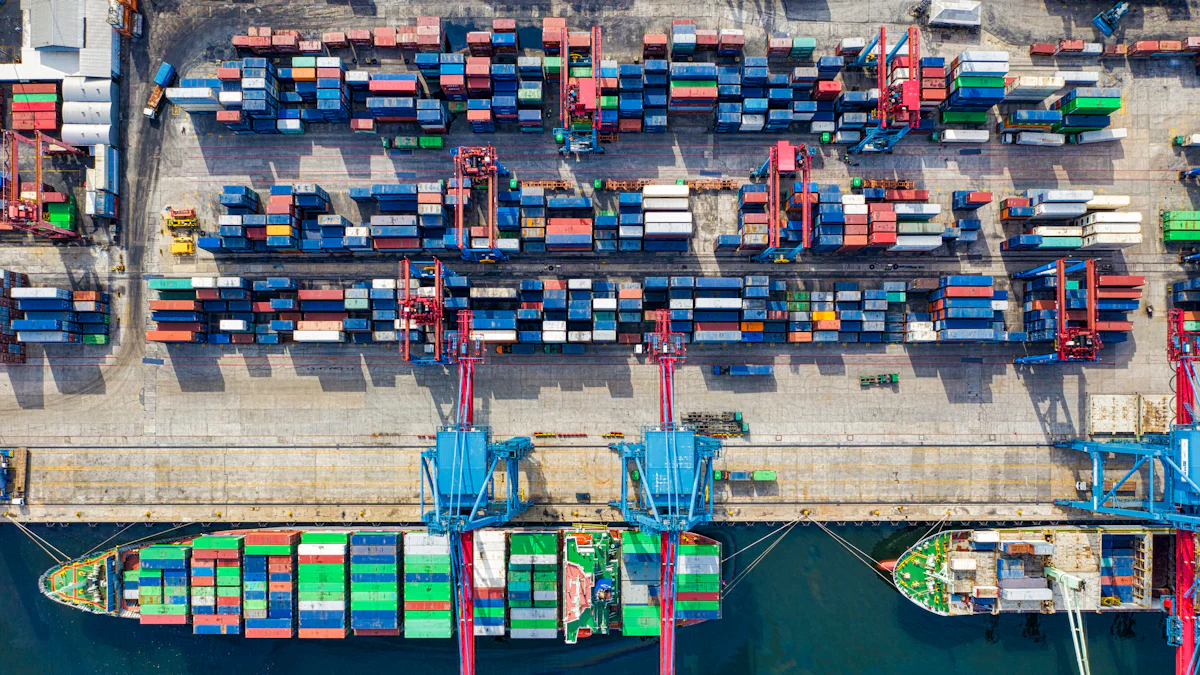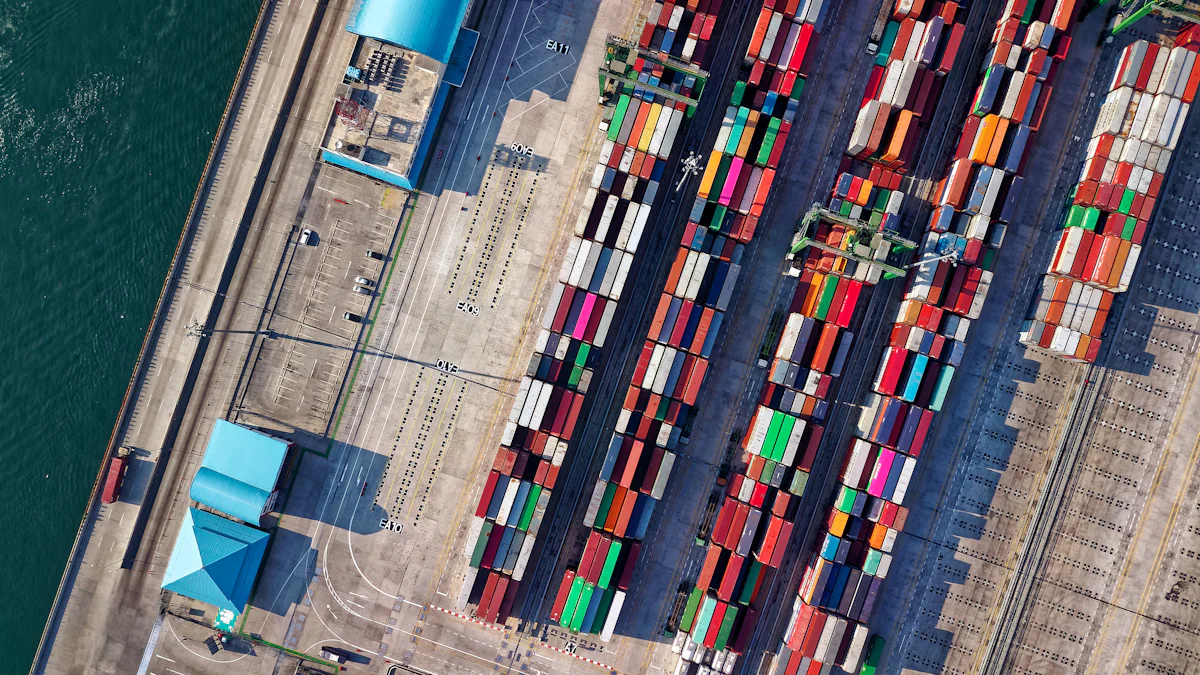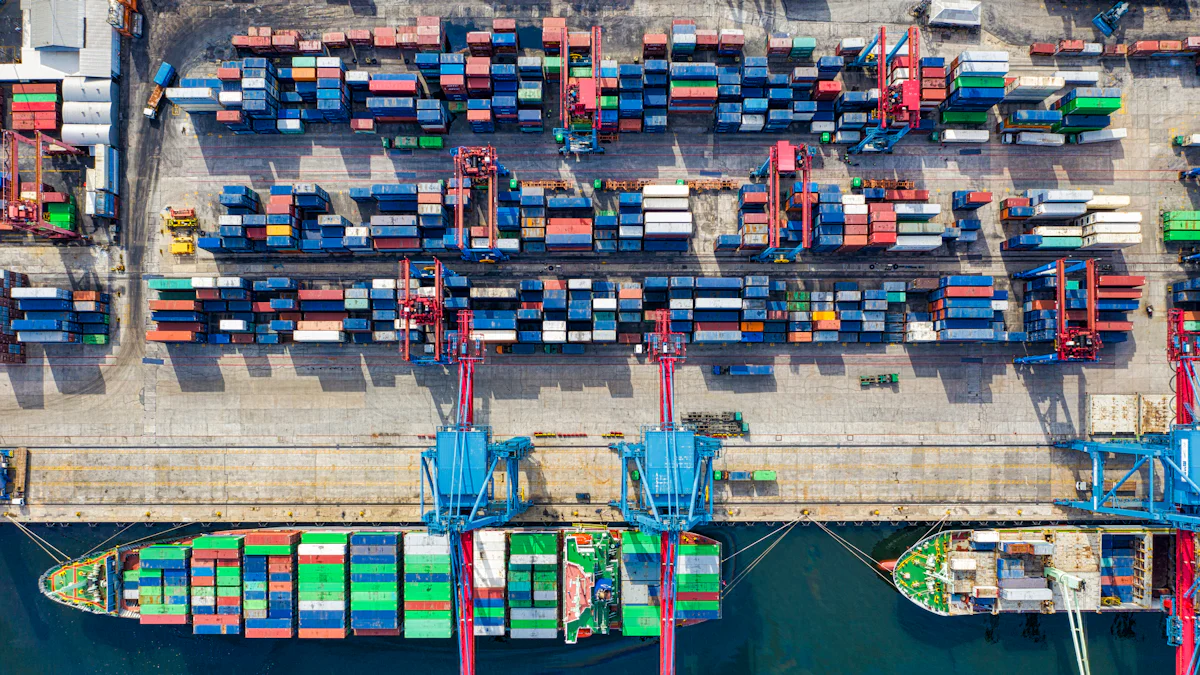How to Improve Supply Chain Visibility

Supply chain visibility holds immense importance in today's market. Companies often face challenges due to a lack of visibility. For instance, 62% of companies report limited visibility, and only 15% have insight into production. These gaps can lead to inefficiencies and increased risks. Improved supply chain visibility offers numerous benefits. Real-time tracking and data-driven insights enhance efficiency and decision-making. Additionally, 80% of businesses have ongoing projects to boost visibility, underscoring its critical role in modern supply chains.
Understanding Supply Chain Visibility
Definition and Key Concepts
What is Supply Chain Visibility?
Supply chain visibility refers to the ability to track every tier of a supply chain. This includes monitoring raw materials, production processes, and delivery to the customer. Companies can gain insights into material, information, and financial flows. This transparency helps in identifying inefficiencies and mitigating risks.
Key Components of Supply Chain Visibility
Key components include:
Real-Time Data Tracking: Monitoring goods and materials in real-time.
Data Integration: Consolidating data from various sources for a unified view.
Predictive Analytics: Using data to forecast future trends and demands.
Collaboration Tools: Facilitating communication among stakeholders.
Current State of Supply Chain Visibility
Common Challenges
Many companies face several challenges in achieving supply chain visibility:
Data Silos: Isolated data systems hinder comprehensive tracking.
Lack of Standardization: Inconsistent data formats complicate integration.
Limited Technology Adoption: Some firms still rely on outdated systems.
Complex Global Networks: Managing international supply chains adds complexity.
Industry Statistics and Trends
The current state of supply chain visibility reveals some critical trends:
62% of companies report limited visibility into their supply chains.
Only 15% have insight into production processes.
80% of businesses have ongoing projects to enhance visibility.
Firms with high visibility achieve higher profitability compared to those with less visibility.
"Supply chain visibility is the ability to track every tier of your supply chain – from the raw materials to the customer." - Worldfavor Blog
These statistics underscore the importance of investing in visibility solutions. Enhanced visibility leads to higher productivity, happier customers, and greater profits.
Benefits of Improved Supply Chain Visibility

Enhanced Efficiency
Streamlined Operations
Supply chain visibility enhances operational efficiency. Companies can monitor every step of the supply chain in real-time. This transparency helps identify bottlenecks and inefficiencies. For example, firms with high visibility have reported a 35% improvement in inventory levels. Digital dashboards provide end-to-end visibility, allowing for better coordination across departments.
Reduced Lead Times
Real-time tracking reduces lead times significantly. Early adopters of AI-enabled supply chain visibility systems have seen a 15% reduction in logistics costs. These systems predict potential delays and suggest alternative routes. This proactive approach ensures timely deliveries and reduces downtime.
Better Decision Making
Data-Driven Insights
Supply chain visibility offers data-driven insights. Companies can analyze data from various sources to make informed decisions. For instance, firms with integrated visibility systems have improved demand planning. This leads to better resource allocation and higher profitability.
Predictive Analytics
Predictive analytics play a crucial role in supply chain visibility. These tools forecast future trends and demands. Companies can prepare for market fluctuations and avoid stockouts. CEOs have noted that AI tools deliver a strong ROI. Predictive analytics create new opportunities without reducing employment.
Increased Customer Satisfaction
Real-Time Tracking
Real-time tracking enhances customer satisfaction. Customers can monitor their orders at every stage. This transparency builds trust and loyalty. Companies with high supply chain visibility report higher customer retention rates. Real-time updates keep customers informed and satisfied.
Improved Communication
Effective communication is vital for supply chain visibility. Collaboration tools facilitate seamless interaction among stakeholders. Transparent communication channels reduce misunderstandings and errors. Companies can address issues promptly, ensuring smooth operations. Improved communication leads to higher customer satisfaction and better service levels.
Strategies to Improve Supply Chain Visibility

Implementing Technology Solutions
AI-Driven Systems like JusLink
AI-driven systems like JusLink enhance supply chain visibility by leveraging advanced analytics and machine learning. These systems compile and analyze data from various supply chain tiers, providing real-time insights. Companies can detect abnormal changes in supply and demand, forecast potential material shortages, and gauge market demand. AI tools improve decision-making and operational efficiency. For instance, AI can map supply chain tiers and predict potential disruptions before they occur.
Digital Platforms for End-to-End Visibility
Digital platforms offer comprehensive solutions for end-to-end supply chain visibility. These platforms integrate various systems, covering the entire process from purchase order creation to delivery. Companies can monitor goods and materials in real-time, ensuring transparency across all stages. Digital platforms provide a unified view of the supply chain, facilitating better coordination among departments. This integration reduces lead times and enhances overall efficiency.
Middleware and Automation Tools
Middleware and automation tools streamline supply chain operations. Middleware facilitates data exchange between different systems, ensuring seamless communication. Automation tools enhance real-time monitoring and operational management. Companies can automate routine tasks, reducing manual errors and improving accuracy. These tools support proactive decision-making, enabling companies to respond swiftly to changes in the supply chain.
Data Integration and Management
Centralized Data Platforms
Centralized data platforms consolidate information from various sources into a single repository. This centralization provides a unified view of the supply chain, enhancing supply chain visibility. Companies can access real-time data, enabling better decision-making and coordination. Centralized platforms also support data analysis, helping identify trends and areas for improvement.
Data Standardization
Data standardization ensures consistency across all supply chain nodes. Standardized data formats facilitate seamless integration and communication. Companies can easily share information with stakeholders, reducing misunderstandings and errors. Data standardization enhances the accuracy of predictive analytics, improving resource planning and demand forecasting.
Real-Time Monitoring
Real-time monitoring is crucial for effective supply chain visibility. Companies can track goods and materials at every stage of the supply chain. Real-time updates provide up-to-date information on the status of shipments, enabling proactive decision-making. This transparency helps identify bottlenecks and inefficiencies, ensuring timely deliveries and reducing downtime.
Collaboration and Communication
Partner Collaboration
Partner collaboration plays a vital role in enhancing supply chain visibility. Companies must work closely with suppliers, manufacturers, and logistics providers. Collaborative platforms facilitate seamless interaction among stakeholders, ensuring transparency and coordination. Effective collaboration helps address issues promptly, maintaining smooth operations and improving overall efficiency.
Transparent Communication Channels
Transparent communication channels are essential for effective supply chain visibility. Clear and open communication reduces misunderstandings and errors. Companies can share real-time updates with stakeholders, keeping everyone informed. Transparent communication builds trust and fosters strong relationships, enhancing overall supply chain performance.
Real-World Examples and Case Studies
Successful Implementations
Case Study 1: Company A
Company A faced significant challenges with supply chain visibility. The company struggled with data silos and outdated systems. Management decided to implement AI-driven systems and digital platforms for end-to-end visibility. This decision transformed operations.
Real-Time Data Tracking: Company A integrated real-time tracking across all supply chain tiers.
Data Integration: The company consolidated data from various sources into a centralized platform.
Predictive Analytics: AI tools forecasted potential disruptions and optimized resource planning.
The results were remarkable. Company A saw a 20% reduction in lead times and a 30% improvement in inventory levels. Customer satisfaction increased due to real-time order tracking and transparent communication.
Case Study 2: Company B
Company B operated in a complex global network. The company faced difficulties managing international supply chains. To address these issues, Company B adopted middleware and automation tools.
Middleware Implementation: Middleware facilitated seamless data exchange between different systems.
Automation Tools: Automation enhanced real-time monitoring and operational management.
Collaboration Tools: The company used collaboration platforms to improve stakeholder communication.
These changes led to significant improvements. Company B achieved a 25% increase in operational efficiency and a 15% reduction in logistics costs. The company also reported higher profitability and customer retention rates.
Lessons Learned
Key Takeaways
Several key takeaways emerged from these case studies:
Technology Adoption: Implementing advanced technologies like AI and digital platforms enhances supply chain visibility.
Data Integration: Centralized data platforms and middleware ensure seamless data exchange and real-time monitoring.
Collaboration: Effective communication and collaboration among stakeholders are crucial for smooth operations.
Common Pitfalls to Avoid
Companies should avoid common pitfalls when improving supply chain visibility:
Ignoring Data Silos: Isolated data systems hinder comprehensive tracking and decision-making.
Lack of Standardization: Inconsistent data formats complicate integration and analysis.
Limited Technology Use: Relying on outdated systems reduces efficiency and increases risks.
By learning from these examples, companies can enhance supply chain visibility, leading to higher efficiency, profitability, and customer satisfaction.
FAQs on Supply Chain Visibility
Common Questions
What are the initial steps to improve visibility?
Assess Current State: Evaluate existing supply chain processes. Identify pain points and areas needing visibility improvements.
Define Objectives: Outline clear goals for supply chain visibility. Examples include real-time tracking, risk management, or improved collaboration.
Choose Technology: Select appropriate technology solutions. Options include AI-driven systems, digital platforms, and middleware.
Data Integration: Implement systems to collect and integrate data across all supply chain nodes.
Real-Time Monitoring: Ensure platforms support real-time monitoring of goods and materials.
How can small businesses benefit from improved visibility?
Enhanced Efficiency: Small businesses can streamline operations. Real-time tracking helps identify bottlenecks and inefficiencies.
Better Decision Making: Data-driven insights enable informed decisions. Improved demand planning leads to better resource allocation.
Increased Customer Satisfaction: Real-time tracking builds customer trust. Transparent communication enhances customer loyalty.
Risk Mitigation: Visibility helps identify potential risks. Proactive measures reduce disruptions and ensure smooth operations.
Cost Reduction: Efficient operations lower logistics costs. Predictive analytics optimize inventory levels and reduce waste.
Expert Answers
Insights from Industry Leaders
"Manufacturers can achieve supply chain visibility using a combination of data, technology, and processes that help them track activities in real time." - Supply Chain Management Expert
Industry leaders emphasize integrating data from various sources. This includes procurement, planning, inventory, and fulfillment systems. External data such as market insights and regulatory changes should also be incorporated. This combined insight helps executives make confident decisions about raw material requirements and transportation options.
"Supply chain executives should embrace intelligent visibility to make their operations transparent and their supply chain resilient." - Supply Chain Resilience Expert
Intelligent visibility helps avoid excess costs and inefficiencies. Full visibility into the supply chain improves the bottom line. Executives can make informed decisions, enhancing overall operational efficiency.
Practical Advice
Integrate Data Systems: Combine data from ERP, CRM, and other systems. This provides a unified view of the supply chain.
Use Advanced Analytics: Leverage predictive analytics to forecast trends. Prepare for market fluctuations and avoid stockouts.
Adopt Collaboration Tools: Facilitate seamless interaction among stakeholders. Effective communication ensures smooth operations.
Monitor in Real Time: Implement real-time tracking systems. This transparency helps identify and address issues promptly.
Stay Updated: Keep abreast of technological advancements. Continuously iterate on supply chain solutions to maintain competitiveness.
Supply chain visibility holds critical importance for modern businesses. Enhanced visibility drives operational efficiencies that increase productivity, profitability, and customer satisfaction. Companies must implement strategies such as AI-driven systems, data integration, and real-time monitoring. These approaches foster resilience and better decision-making. Strategic visibility also positions businesses for long-term success. Embracing these solutions will lead to continuous improvement and innovation in supply chain management.
See Also
The Power of Visibility in Revolutionizing Supply Chain Efficiency
Optimizing Operations: JUSDA's Comprehensive Supply Chain Transparency
Consistent Clarity: A Crucial Element for Supply Chain Excellence
Driving Growth: How Supply Chain Visibility Impacts Global Online Retail
